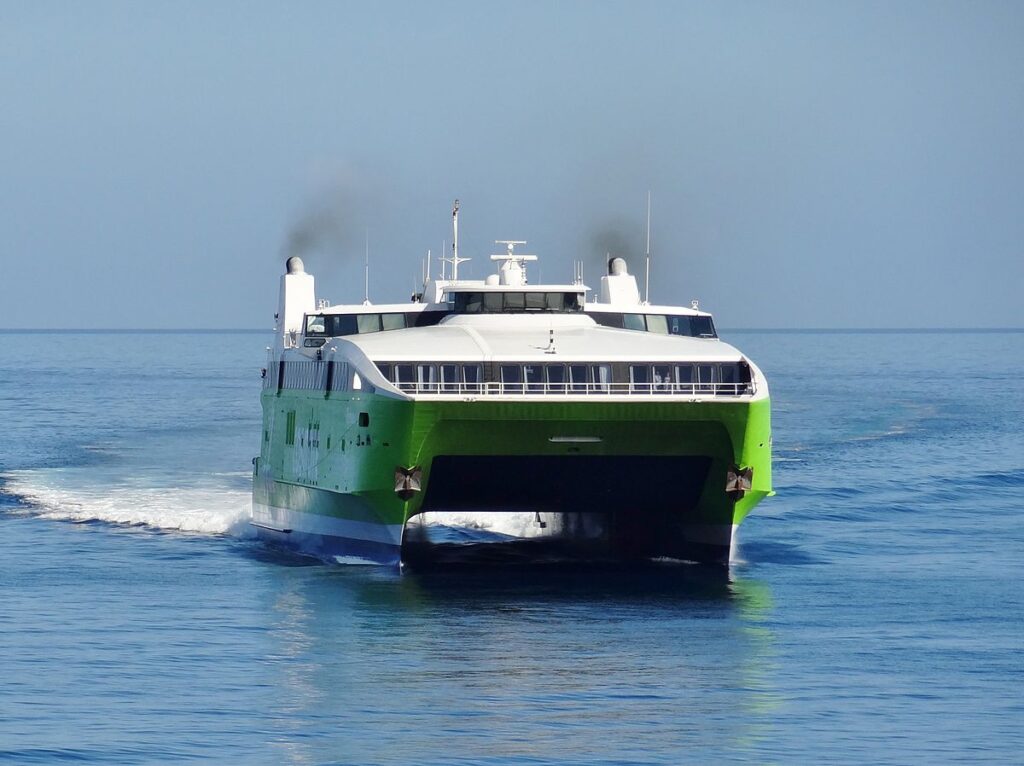Ferries in Greece
Introduction
This guide to ferries in Greece will help you easily plan a trip to the Greek islands. Includes information about Greek ferries, how to book online, and more!
- Booking Greek Ferries Online: This is a good way to book ferries in Greece and other Mediterranean countries. It’s also good for researching ferry timetables, costs, and schedules. But for peace of mind, book tickets 2 to 3 months in advance.
- Check Barcode and check-in: If a ticket purchased online doesn’t have a barcode, you’ll need to pick up an actual ticket when you are in Greece. This is often done at the ferry port 30 to 45 minutes before departure. For e-tickets, you do not have to pick up a paper ticket before boarding. Instead, online check-in is available 48 hours to 30 minutes before departure, after which you can download your boarding pass to your phone.
- Timing of ferries: Ferries leave on time from their first departure port in the morning (usually large ports like Piraeus, Heraklion, and Rhodes) but arrive and depart late from all onward ports—usually getting later as the day progresses.
- Strikes: Most areas in Greece have public transportation strikes on various dates throughout the year. These strikes can affect all forms of transit, including buses, trains, ferries, flights, and taxis. During strikes, no buses, no ferries, and only a handful of trains and flights will depart on time (or at all). Avoid booking any ferries, flights, or trains that day.

- Ferry routes between Greek Islands run most frequently from June to September. March-April-May and October ferries run on a limited schedule. From late November to Early March, there is a very limited schedule between some islands, and sometimes, the ferries are canceled due to bad weather.
- There is no ferry pass for Greece or Greek islands.
Common Ferry Routes for the Greek Islands
- Athens to the Greek Islands – For almost all Greek islands in the Aegean, there is at least one ferry per day to and from Athens, 365 days a year. Two ferry ports serve Athens – Piraeus is closer to the city, and Rafina is closer to the airport. Most travelers will want to use Piraeus, as it is easy to access via central Athens and serves the most ferry routes to the islands. Ferries departing from the Athens ports connect the capital with the following island groups:
- Mykonos to Santorini – Daily ferries usually run from late March to early October. In other months, you’ll need to ferry or fly via Athens.
- Naxos, Paros, Ios to Santorini – Daily ferries usually run year-round.
- Crete to Santorini – Daily ferries usually run from late March to late October. In other months, you’ll need to ferry or fly via Athens.
- Rhodes to Crete – Sporadic service year-round, often on an overnight service.
- Rhodes to Santorini, Mykonos, Cyclades – There are daily ferries from Rhodes to Athens that will sometimes make stops in a Cycladic island (usually Syros, Naxos, or Paros). From there you can take a ferry to other Cycladic islands.
- Corfu to Santorini, Crete, Mykonos – There are no ferries from the west coast islands (Corfu, Zakynthos, Kefalonia) to the Cycladic islands, Crete, Rhodes, or any of the islands in the Aegean.
- The Sporades islands, including Skiathos and Skopelos, can be reached through mainland Greece. You’d have to leave from Volos or the small port of Agios Konstantinos near Kamena Vourla. The Sporades are also connected with Evia island.
- The Ionian islands are a separate group, located west of mainland Greece. They can be approached on ferries from Patras, Kyllini and Igoumenitsa in Western Greece. For people pushed for time, flying might be easier.
- Italy to Greece—There are summer ferries from the east coast of Italy to the west coast of Greece (Corfu, Igoumenitsa, Patras) but no ferries from Italy to Crete, Santorini, Mykonos, or any of the islands in the Cyclades.
- Greece to Turkey Ferries
Notes
- Traveling directly between islands of the same group is not always possible. Even islands that look very close on the map may not be directly connected at all. For instance, the increasingly popular island of Antiparos can only be reached through the island of Paros.
- It is possible to travel between some of these island groups by ferry. As an example, Crete is directly connected to many of the Cyclades islands. Similarly, some of the Cyclades are connected to the Dodecanese, and to certain Northeastern Aegean islands.
- Kavala port is connected with islands like Lemnos, Lesvos, Chios, and certain islands in the Dodecanese. Ferries from Alexandroupolis port depart for Samothraki island.
- The popular Paros – Antiparos route does not appear on search engines. We assure you that this route is served by two different ferries, many times a day.
Seating Options
Seating options on Greek ferries vary widely and depend on the type of vessel. Smaller, faster ferries only have indoor seating options. Sometimes there may be more than one type of seat, such as standard, business and VIP. While some people might find the upgrade more comfortable, it depends on the ferry. Medium-sized highspeed ferries also have reserved indoors seating. Again, there are more than one types of seats. If comfort is an issue, you might want an upgrade, especially if you are travelling in peak season. You may be able to stand on the deck for a while, but in general you won’t find designated seating areas on the deck. The conventional passenger / car ferries have all sorts of seats. The economy / deck option gives you the right to sit anywhere on the deck, or in designated indoors areas. If you aren’t prepared to fight for your seat, booking reserved “airplane” seats might be the best option for you. You will have your own seat and will still be able to walk around most areas of the ferry. For longer trips, or on overnight routes, you could also consider getting a cabin. There are different types of cabins, which have anywhere from one to four beds. The most luxurious (and expensive) options are normally cabins with a sea view.

Vessel Types
Large Car/Passenger Ferries

High Speed Ferries

Small Catamarans

Faqs About Ferries in Greece
- Are ferries rough? Will I get seasick on a Greek ferry? Ferries can be bumpy during rough seas and windy weather. Generally, the bigger the ferry the smoother the ride. If you’re susceptible to seasickness then try to travel on the Blue Star ferry. I find getting up and walking about can lead to seasickness even if you were feeling fine. Try to stay seated as much as possible. They do have sick bags too, so ask for them when you board if you think it might be an issue.
- How long before departure should I arrive at the ferry port? 30 minutes is fine, maybe 45 minutes if you have to pick up your reserved tickets. Ferries do not wait for anyone.
- What if my ferry gets rescheduled? Ferry schedules can and do change, often within days of a scheduled departure. (This is a good reason to wait to pick up your tickets until you’re at the port. If you print your ticket before a schedule occurs, you’ll have to deal with the hassle and fees involved with getting a new, correct, ticket printed.) In the case of a schedule change, you will receive a notification via email or text. Usually, the change in departure time is minimal, but if the new scheduled time doesn’t work for your itinerary, you will have to cancel your ticket and make alternate travel plans. Note that a scheduling change may be due to a routing change, making your trip longer – or shorter – than expected. If you have timing concerns, it’s a good idea to double check the vessel’s route.
- What if my ferry gets canceled? In the rare case that your ferry route is canceled altogether, you will be responsible for finding and making new travel plans. Cancellation fees are generally not incurred.
- What is the best way to get from central Athens to the Piraeus ferry port? There is a direct train from downtown Athens (Monastiraki station) to the Piraeus ferry port. It takes about 20 minutes from central Athens to the ferry port.
- What is the best way to get from the Athens airport to the Piraeus ferry port? The easiest way from the airport to the ferry port is the train. First, take the airport train into Athens. Switch trains at the Monastiraki station to the M1 line which will take you straight to the ferry port. Trains do not run 24 hours so if you’re traveling in the middle of the night then use the X96 bus to the ferry port.
Best Island Hopping Tour Packages
- Athens – Mykonos – Santorini | 10 Days
- Athens – Naxos – Santorini – Crete | 14 Days
- Athens – Milos – Folegandros – Santorini | 11 Days
Best Island Short Breaks Packages
- Mykonos Short Break | 2 Days
- Santorini Short Break | 3 Days
- Skiathos Short Break | 3 Days
- Rhodes Island Short Break | 3 Days










